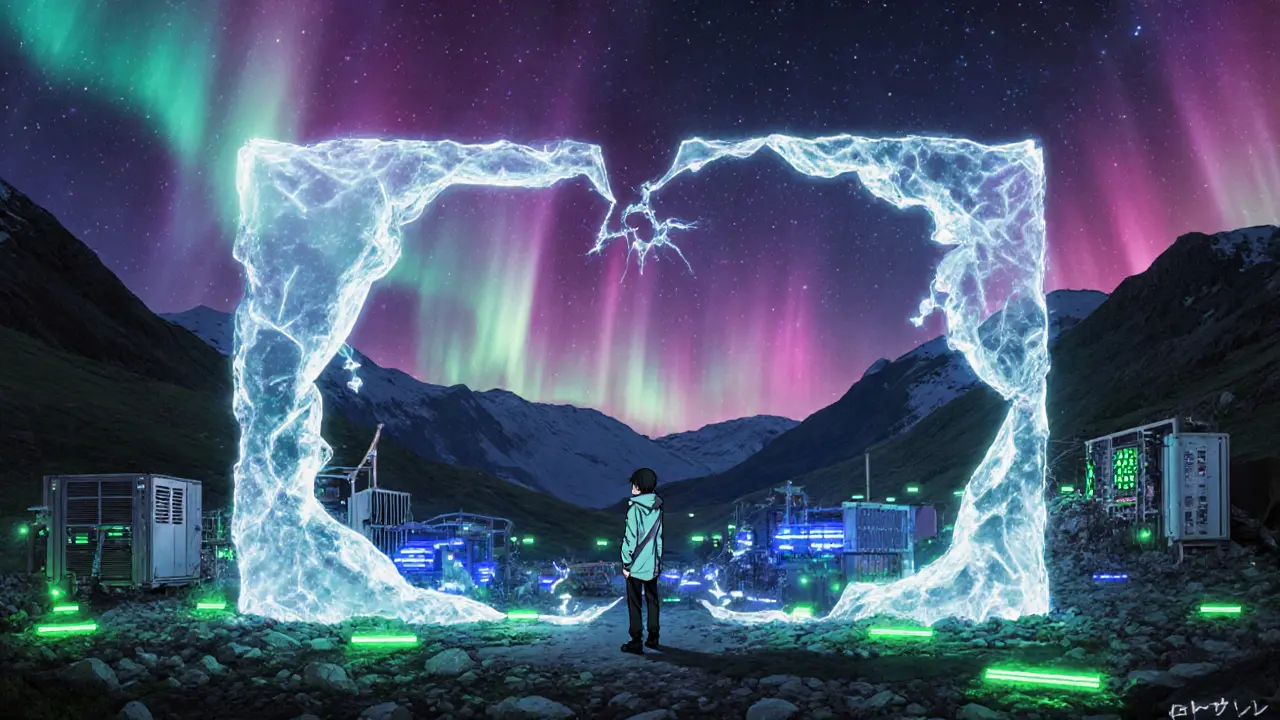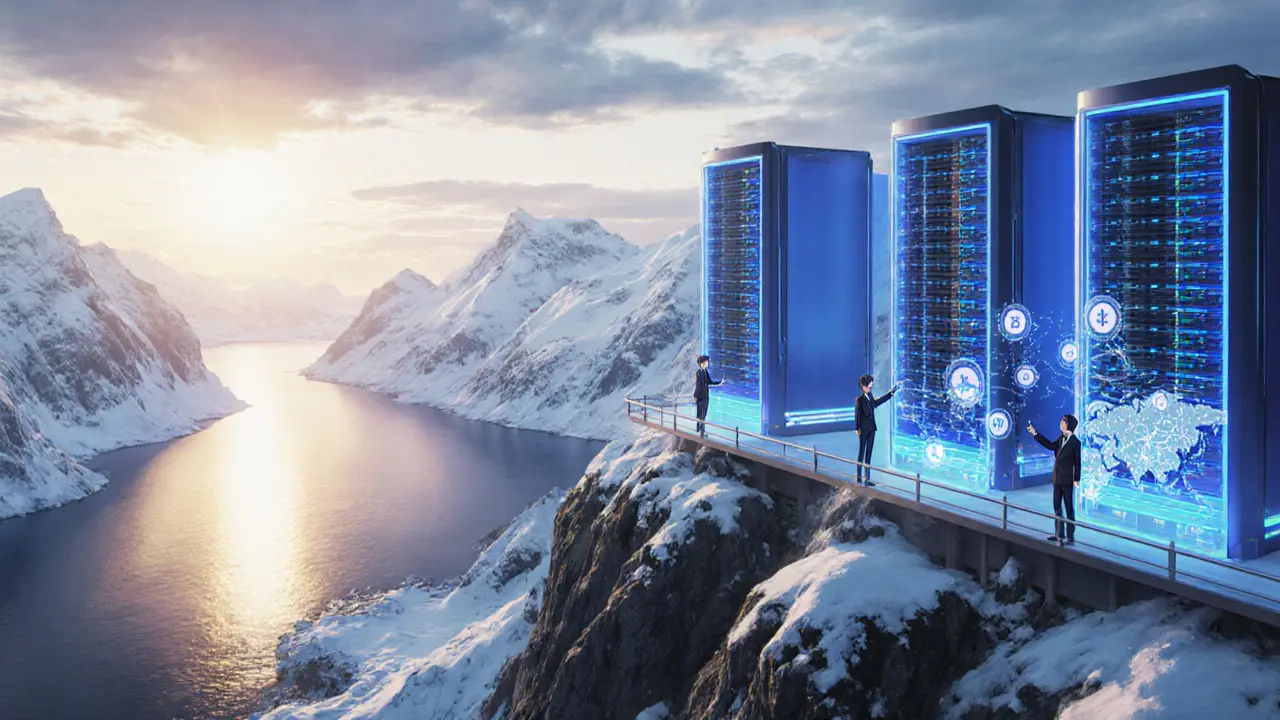Norway Crypto Mining Compliance Checker
This tool helps determine if your crypto mining facility meets Norway's 2025 regulatory requirements.
Compliance Summary
- 1 All data centers must register with Nkom before construction or by July 1, 2025
- 2 New high-energy mining facilities banned starting Autumn 2025
- 3 Non-compliance penalties up to 5% of annual turnover
- 4 SHA-256 and Ethash algorithms are considered high-intensity
Quick Takeaways
- Norway introduced a national data‑center registry on Jan12025, forcing all crypto‑mining facilities to register with Nkom.
- A temporary ban on new power‑intensive mining data centers starts in autumn2025, leaving existing sites only a short transition window.
- Non‑compliance can cost up to 5% of annual turnover - one of Europe’s toughest penalties.
- Regulators cite energy‑conservation and low‑job‑creation as reasons, despite Norway’s abundant hydro power.
- Compared with Iceland, Sweden and Finland, Norway is the most restrictive European jurisdiction for new crypto‑mining builds.
Why Norway Went From Renewable Power Haven to Crypto‑Mining Gatekeeper
When it comes to Norway's cryptocurrency mining data center regulations - a legal framework that forces crypto‑mining operators to disclose detailed operational data and subjects new high‑energy projects to a temporary ban - the country has taken a dramatic turn.
Until 2024, Norway’s cheap, carbon‑free hydroelectric grid attracted global mining firms looking for sustainable power. The Labour Party’s 2021‑2024 energy‑policy platform, however, grew uneasy about a sector that burns megawatts while offering limited local jobs. In April2024 the government announced a two‑pronged approach: a mandatory registration system administered by the Norwegian Communications Authority (Nkom) and an autumn2025 moratorium on any new, energy‑intensive mining data centre.
Key Players and Their Roles
The regulatory landscape involves several distinct entities, each with a clear mandate.
- Norwegian Communications Authority (Nkom)enforces the national data‑center registry, verifies submissions and levies penalties.
- Ministry of Digitalization and Public Administrationled by Minister Karianne Tung, sets the overall digital‑policy direction and backs the ban.
- Ministry of Energyunder Minister Terje Aasland, balances electricity allocation between traditional industry and crypto mining.
- Norwegian Electronic Communications Acteffective 1Jan2025, creates the first European national data‑center registry.
These bodies coordinate through joint working groups, ensuring that registration data feeds directly into the energy‑allocation model used by the Ministry of Energy.

What the Registration System Demands
All data‑center operators - including those solely dedicated to crypto mining - must submit a comprehensive dossier before construction begins or, for existing facilities, by 1July2025. The dossier includes:
- Company name, legal form and VAT number.
- Physical address of the data‑center and GIS coordinates.
- Designated representative (name, phone, email) for official correspondence.
- Detailed service description, explicitly stating whether mining hardware is hosted.
- Customer list broken down by public agencies versus private firms.
- Estimated annual electricity consumption (kWh) and the share attributed to mining.
Failure to provide any of these fields triggers an automatic audit. If the operator cannot prove compliance, Nkom may impose a fine of up to 5% of the company's yearly turnover - a penalty that dwarfs typical environmental fines in the EU.
Understanding the Temporary Ban
The ban, announced in April2024 and slated for activation in autumn2025, targets only new facilities that use the most energy‑intensive mining algorithms (e.g., SHA‑256, Ethash). It does crypto mining restrictions Norway by preventing any new construction or expansion of crypto‑mining data centres until the government revises the policy.
Key points of the ban:
- Existing sites may continue operating but cannot enlarge their footprint or double‑up on power contracts.
- The energy‑intensity threshold is not publicly defined, leaving borderline projects in legal limbo.
- Violators face the same 5% turnover fine plus possible revocation of electricity licences.
- Authorities reserve the right to extend the moratorium beyond its “temporary” label if climate goals demand it.
Minister Karianne Tung summed it up: “We want to limit mining as much as possible while protecting jobs in traditional sectors.” Energy Minister Terje Aasland added that the move “redirects electricity to industries that provide greater social and economic benefits.”
How Norway’s Approach Stacks Up in the Nordics
| Country | Primary Energy Source | Regulatory Stance | Typical Electricity Cost (€/MWh) | Crypto‑Mining Friendliness |
|---|---|---|---|---|
| Norway | Hydro‑electric (≈99%) | Mandatory registration + temporary ban on new high‑intensity sites | ≈0.04 | Low - existing sites only, no new builds |
| Iceland | Geothermal & hydro | Light licensing, no formal bans | ≈0.06 | High - strong mining clusters |
| Sweden | Hydro, nuclear, wind | Permitting required, but no specific crypto restrictions | ≈0.07 | Medium - growing interest |
| Finland | Hydro, nuclear | Standard data‑center permits, environmental review only | ≈0.08 | Medium - selective uptake |
Norway’s model is the only one that explicitly blocks new high‑energy mining projects, putting it ahead of the EU‑wide MiCA rollout in terms of strictness. The table shows why several international miners are now eyeing Iceland or Sweden for fresh investments.

Impacts on the Crypto‑Mining Industry
Since the announcement, several multinational mining firms have paused or cancelled planned Norwegian projects. A 2025 survey by the Nordic Mining Association reported that 42% of respondents shifted capital to Iceland or the US Pacific Northwest, citing “regulatory certainty” as the main driver.
For operators that remain in Norway, the compliance burden is real:
- Legal counsel fees average €150,000 per year for registration upkeep.
- Ongoing reporting (quarterly electricity use, customer updates) adds 10‑15% to operational overhead.
- Uncertainty around the energy‑intensity threshold makes risk‑assessment models more complex.
On the flip side, environmental NGOs applaud the policy. A 2025 report from the Norwegian Institute for Renewable Energy estimated that the ban could shave up to 3TWh of crypto‑related electricity demand annually - roughly the yearly consumption of a mid‑size Norwegian city.
Future Outlook: Will the Ban Stay Temporary?
Government officials have hinted that the autumn2025 moratorium is a pilot. The Ministry of Energy will review the measure against the nation’s 2030 climate targets. If the mining sector’s hash‑rate contribution continues to be deemed “low‑value,” a permanent prohibition could emerge.
Two scenarios are most likely:
- Extended Ban with Clear Thresholds - The authorities publish a concrete kWh‑per‑hash metric, allowing borderline operators to adapt or exit.
- Regulatory Relaxation for Low‑Impact Technologies - Proof‑of‑Stake or other low‑energy consensus mechanisms might earn a carve‑out, encouraging greener crypto ventures.
Stakeholders should monitor upcoming MiCA implementation notes (expected Q42025) because they will overlay additional reporting requirements on top of the existing Norwegian framework.
Practical Checklist for Crypto‑Mining Operators in Norway
- Verify that your data centre is fully registered with Nkom before 1July2025.
- Document electricity consumption per mining device; be ready to disclose in quarterly reports.
- Assess whether your hardware falls under the “most energy‑intensive” category - if unsure, consult a local energy‑law specialist.
- Plan for a potential relocation or diversification into low‑energy consensus services.
- Stay updated on MiCA guidance from the Financial Supervisory Authority (FSA) - overlapping compliance is inevitable.
Frequently Asked Questions
Do existing crypto‑mining data centres have to stop operations?
No. Existing facilities can continue mining but cannot expand capacity or build new high‑energy rigs after the July2025 registration deadline. Any expansion would be subject to the same ban that applies to new projects.
What counts as “energy‑intensive” under the ban?
The government has not published a precise kWh threshold yet. In practice, algorithms like SHA‑256 (Bitcoin) and Ethash (Ethereum) are considered high‑intensity. Operators should assume any device consuming more than 1kWh per GH/s will fall under the ban.
How much can the fine be for non‑compliance?
Nkom can levy a penalty up to 5% of the operator’s annual turnover, making it one of the steepest enforcement tools in the European data‑center sector.
Will the temporary ban affect other data‑center services?
No. The ban specifically targets new crypto‑mining facilities. Cloud‑hosting, AI workloads, and traditional IT services remain unaffected, provided they are not primarily used for mining.
How does MiCA interact with Norway’s mining rules?
MiCA introduces EU‑wide reporting for crypto‑asset service providers. Norwegian miners will need to comply with both MiCA disclosures and the national registration, meaning double documentation for legal, financial, and energy‑use data.


Post Comments (25)
Hey folks, if you're thinking about setting up a mining rig in Norway, the first thing you gotta do is get that Nkom registration sorted before the July deadline. It might feel like paperwork, but treating it like a checklist will save you headaches later. Keep track of your energy consumption per device, and make sure you have a clear point of contact ready for any regulator calls. Remember, the ban only hits new high‑energy projects, so if you can adapt to low‑intensity algorithms you’re still good to go. Also, don’t forget to keep an eye on the upcoming MiCA rules – they’ll add another layer of reporting. Stay organized, stay compliant, and you’ll ride this wave without a crash.
Reflecting on the broader picture, the Norwegian stance highlights a shift where sustainability overrides pure profit motives. By mandating transparency, the state nudges miners toward greener tech, which could accelerate innovation in low‑energy consensus mechanisms. This regulatory pressure might seem restrictive, yet it fosters a more resilient ecosystem that aligns with climate goals. In the long run, operators who adapt early could gain a competitive edge, leveraging Norway’s cheap hydro to power truly sustainable mining.
Honestly, this whole ban feels like a power grab. They’re just scared of competition and use “environment” as an excuse.
Yo, anyone wondering if the registration is a pain? Trust me, it’s just a form. Fill it out, submit the required electricity numbers, and you’ll be good. The real trick is documenting your hash‑rate per kilowatt – that’ll make any audit a breeze. Keep those numbers tidy and you won’t have to worry about the 5% fine. Also, consider diversifying into proof‑of‑stake projects – they’re low‑energy and won’t trigger the ban.
From a strategic standpoint, Norway’s hydro advantage is being re‑engineered into a compliance framework. The registry functions as a data lake, feeding into the national grid’s load‑balancing algorithms. Operators should treat the submission as a data‑integration exercise, aligning their telemetry stacks with Nkom’s schema. This way, you future‑proof your operation against both national and EU‑wide reporting mandates.
Wow 😒 another “green” regulation that’ll just push miners to offshore havens…
This policy is overkill and will kill innovation.
While I concede that regulatory overreach can stifle entrepreneurial vigor, one must also acknowledge that Norway’s hydro‑rich topology presents a unique confluence of low‑cost electricity and advanced grid stability. Therefore, a measured approach-rather than an outright ban-could harness this potential without compromising environmental imperatives.
Did anyone see the fine? 5% of turnover! That could bankrupt a mid‑size operation overnight. Think about the ripple effects on the local job market-people will lose wages, families will suffer. This isn’t just about crypto; it’s about community livelihoods.
In the grand tapestry of technological evolution, the Norwegian decree manifests as a microcosm of humanity’s perpetual tussle between progress and prudence. When we embed regulatory scaffolding around emergent industries, we partake in a dialectic that balances ecological stewardship with economic ambition. The ban on high‑intensity mining rigs, albeit seemingly draconian, reflects an ethical calculus wherein the externalities of energy consumption are weighed against the societal benefit of sustainable development. Moreover, the mandated registration process serves as a conduit for data transparency, enabling policymakers to construct more informed energy distribution models. As the European MiCA framework looms, operators must navigate a labyrinth of compliance checkpoints, each demanding granular disclosures of hash‑rate, power draw, and financial flows. This intricate web, while onerous, could catalyze a shift toward low‑energy consensus mechanisms, invigorating research into proof‑of‑stake and other eco‑friendly protocols. Consequently, the regulatory pressure may inadvertently sow the seeds of innovation, propelling the industry toward greener horizons. In essence, what appears as a restriction today might well be the crucible in which the next generation of sustainable blockchain technologies is forged.
Listen up: if you ignore the July 1 registration you’re basically signing up for a 5% turnover hit. That’s not a joke. Get your legal counsel, fill that dossier, and submit the exact kWh numbers. Any vague estimate will trigger an audit, and audits cost time and money. Make it crisp, make it accurate, and you’ll stay out of the penalty zone.
Hey team, just a heads‑up: the Nkom portal now lets you upload your electricity logs directly. It’s pretty user‑friendly, so don’t stress about the paperwork. Keep the team in the loop and share the link with everyone who handles reporting.
Good point about proof‑of‑stake. Switching to low‑energy methods could keep us clear of the ban.
It would be helpful to have a clear definition of the kWh‑per‑hash threshold so miners can self‑assess compliance without waiting for regulator clarification.
Seems like Norway is just trying to scare off the competition, nothing more.
🚀 Pro tip: set up a monitoring dashboard that tracks real‑time power draw per rig. When you see spikes, you can throttle or shift load before it becomes a compliance issue.
Do you think the ban will push more miners toward using renewable‑powered data centers in other Nordic countries?
Totally! I see a wave of miners moving to Iceland and Sweden where the regulations are friendlier, and they’ll bring expertise that could eventually benefit Norway’s own ecosystem.
They’re probably doing this to protect big hydro utilities.
The policy is just a distraction from real energy issues.
For operators still in Norway, consider aligning your reporting schedule with the quarterly financial close to streamline compliance.
Imagine a future where Norwegian miners become ambassadors of green crypto, showcasing how sustainable power can power the blockchain without harming the fjords.
Let’s turn this challenge into an opportunity to innovate on low‑energy mining hardware!
Compliance is key.
Navigating Norway’s new crypto‑mining regulations can feel like threading a needle in a blizzard, but breaking the process down into bite‑size steps makes it manageable. First, lock in your Nkom registration well before the July 1 deadline; treat it as the foundation of your compliance house. Second, inventory every piece of hardware and record its exact power draw, because the authorities will want to see granular energy data. Third, map out which algorithms you run – SHA‑256 and Ethash fall under the high‑intensity umbrella, so if you’re using them, you’ll need to either cease expansion or shift to lower‑energy alternatives. Fourth, set up an automated reporting pipeline that dumps your telemetry into the format required by Nkom, reducing the risk of human error. Fifth, keep an eye on the EU’s MiCA rollout, as the overlap of reporting requirements could double‑dip your documentation effort. Sixth, consider diversifying into proof‑of‑stake or other consensus mechanisms that consume a fraction of the electricity. Seventh, engage a local legal advisor who specializes in energy law to interpret any ambiguous thresholds. Eighth, maintain a clear line of communication with your electricity supplier; they can help you adjust contracts if you need to scale back power usage. Ninth, regularly audit your own compliance posture – a quarterly self‑audit can catch issues before regulators do. Tenth, join the Nordic mining forums where peers share best practices and regulatory updates. Eleventh, document every interaction with regulators, including dates, contacts, and outcomes, to build a compliance trail. Twelfth, budget for the potential 5% turnover fine as a contingency, even if you think you’ll be compliant – it’s better to have the funds set aside. Thirteenth, use the forced transparency as a marketing angle, branding your operation as “green‑certified” to attract environmentally conscious investors. Fourteenth, stay adaptable; policy can evolve, and a flexible operation will survive longer. Finally, remember that compliance isn’t just about avoiding penalties – it’s about contributing to a sustainable future for both crypto and the planet.